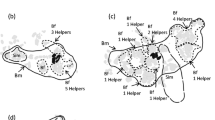Abstract.
Neolamprologus pulcher, a cooperatively breeding cichlid fish from Lake Tanganyika, lives in permanent social groups comprising one breeding pair and helpers of both sexes. Variation in group size (1–14 helpers) provides an opportunity to investigate factors that affect how many helpers remain in a group and in turn how group size affects reproductive success. This field study showed that larger groups live in larger territories with more shelter. Group size was more strongly correlated with territory quality than with breeder size. Experimental enhancement of territory quality did not affect group size but group size decreased when territory quality was reduced. Breeders living in a large group benefit because such individuals feed more often and have lower workloads and greater reproductive success. Helpers in larger groups also fed more frequently but did not have lower workloads. This is one of the first experimental studies to examine the factors influencing group size in cooperative breeders.
Similar content being viewed by others
Author information
Authors and Affiliations
Additional information
Electronic Publication
Rights and permissions
About this article
Cite this article
Balshine, S., Leach, B., Neat, F. et al. Correlates of group size in a cooperatively breeding cichlid fish (Neolamprologus pulcher). Behav Ecol Sociobiol 50, 134–140 (2001). https://doi.org/10.1007/s002650100343
Received:
Revised:
Accepted:
Issue Date:
DOI: https://doi.org/10.1007/s002650100343




